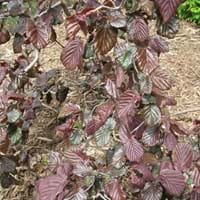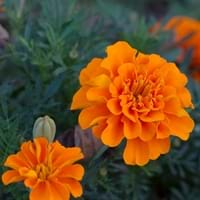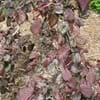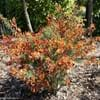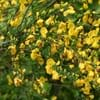Type
Shrub
Flowering Plants, Shrubs
Origin
Europe, Northern Africa, Western Asia
Hybrid origin
Types
Shrub
African or American Marigolds, French Marigolds, Mule Marigolds
Number of Varieties
Not Available
Habitat
Woods
Roadsides, wastelands
USDA Hardiness Zone
4-8
9-11
Sunset Zone
2a, 2b, 3a, 3b, 4, 5, 6, 7, 8, 9, 14, 15, 16, 17, 18, 19, 20
A1, A2, A3, H1, H2, 1a, 1b, 2a, 2b, 3a, 3b, 4, 5, 6, 7, 8, 9, 10, 11, 12, 13, 14, 15, 16, 17, 18, 19, 20, 21, 22, 23, 24
Habit
Thicket/Colonizing
Upright/Erect
Flower Color
Yellow
Orange, Yellow
Flower Color Modifier
Not Available
Bicolor
Fruit Color
Brown
Not Available
Leaf Color in Spring
Green
Green
Leaf Color in Summer
Green, Dark Green
Dark Green
Leaf Color in Fall
Yellow, Green
Dark Green
Leaf Color in Winter
Not Available
Dark Green
Plant Season
Spring, Summer, Fall, Winter
Fall, Spring, Summer
Sunlight
Full Sun, Partial Sun, Partial shade
Full Sun, Part sun
Growth Rate
Medium
Very Fast
Type of Soil
Clay, Loam, Sand
Loamy, Sandy, Well drained
The pH of Soil
Acidic, Neutral, Alkaline
Neutral, Slightly Alkaline
Soil Drainage
Well drained
Well drained
Bloom Time
Early Spring, Spring, Late Winter
Early Fall, Early Summer, Fall, Late Fall, Late Summer, Summer
Tolerances
Not Available
Drought
Where to Plant?
Ground, Pot
Container, Ground, Pot
How to Plant?
Grafting
Seedlings
Plant Maintenance
Medium
Medium
Watering Requirements
Average Water Needs, Do Not over Water
Allow soil to be completely dry in between waterings, Form a Soil ring to water efficiently, Keep the ground moist but not water-logged, Water in morning to avoid prompting diseases, Water when soil is dry
In Summer
Lots of watering
Lots of watering
In Spring
Moderate
Moderate
In Winter
Average Water
Average Water
Soil pH
Acidic, Neutral, Alkaline
Neutral, Slightly Alkaline
Soil Type
Clay, Loam, Sand
Well drained
Soil Drainage Capacity
Well drained
Well drained
Sun Exposure
Full Sun, Partial Sun, Partial shade
Full Sun, Part sun
Pruning
Remove damaged leaves, Remove dead branches, Remove dead leaves
Prune ocassionally, Remove dead or diseased plant parts, Requires little pruning
Fertilizers
All-Purpose Liquid Fertilizer
All-Purpose Liquid Fertilizer
Pests and Diseases
Red blotch
Alternaria Leaf Spot, Bacterial leaf spot, Damping-off, Gray mold, Powdery mildew, Root rot
Plant Tolerance
Drought
Drought
Flower Petal Number
Not Available
Single
Fragrant Bark/Stem
No
Yes
Foliage Texture
Coarse
Fine
Foliage Sheen
Matte
Matte
Attracts
Not Available
Butterflies
Allergy
Not Available
Asthma, Eye irritation, Red eyes, Runny nose, Throat itching, Watery eyes
Aesthetic Uses
Showy Purposes
Showy Purposes
Beauty Benefits
Not Available
Not Available
Environmental Uses
Air purification
Air purification
Medicinal Uses
Minerals, Rich in protein, tonic in pregnancy, Vitamin E
Burns, constipation, Inflammation, Upset stomach, Wounds
Part of Plant Used
Fruits, Leaves, Seeds, Wood
Flowers, Seeds
Other Uses
Culinary use, Used for its medicinal properties
Can be made into a herbal tea, Decoration Purposes, Used As Food
Used As Indoor Plant
No
Yes
Used As Outdoor Plant
Yes
Yes
Garden Design
Feature Plant, Foundation, Mixed Border, Topiary, Bonsai, Espalier
Bedding Plant, Edging, Foundation, Houseplant, Mixed Border
Botanical Name
CORYLUS avellana 'Contorta'
TAGETES 'Cottage Red'
Common Name
common hazel
Marigold
In Hindi
contorted filbert
गेंदा
In German
contorted filbert
Ringelblume
In French
noisetier contorsionné
Souci
In Spanish
avellana contorsionada
Caléndula
In Greek
παραμορφωμένες φουντουκιού
κατιφές
In Portuguese
filbert contorcido
Malmequer
In Polish
wykrzywioną leszczyna
Nogietek
In Latin
contortis Avellanam
Caltha
Phylum
Magnoliophyta
Tracheophyta
Class
Magnoliopsida
Magnoliopsida
Family
Betulaceae
Asteraceae
Clade
Angiosperms, Eudicots, Rosids
Not Available
Tribe
Not Available
Not Available
Subfamily
Not Available
Not Available
Number of Species
Not Available
Importance of Contorted Filbert and Marigold
Want to have the most appropriate plant for your garden? You might want to know the importance of Contorted Filbert and Marigold. Basically, these two plants vary in many aspects. Compare Contorted Filbert and Marigold as they differ in many characteristics such as their life, care, benefits, facts, etc. Every gardener must at least have the slightest clue about the plants he wants to plant in his garden. Compare their benefits, which differ in many ways like facts and uses. The medicinal use of Contorted Filbert is Minerals, Rich in protein, tonic in pregnancy and Vitamin E whereas of Marigold is Burns, constipation, Inflammation, Upset stomach and Wounds. Contorted Filbert has beauty benefits as follows: Not Available while Marigold has beauty benefits as follows: Not Available.
Compare Facts of Contorted Filbert vs Marigold
How to choose the best garden plant for your garden depending upon its facts? Here garden plant comparison will help you to solve this query. Compare the facts of Contorted Filbert vs Marigold and know which one to choose. As garden plants have benefits and other uses, allergy is also a major drawback of plants for some people. Allergic reactions of Contorted Filbert are Not Available whereas of Marigold have Asthma, Eye irritation, Red eyes, Runny nose, Throat itching and Watery eyes respectively. Having a fruit bearing plant in your garden can be a plus point of your garden. Contorted Filbert has no showy fruits and Marigold has no showy fruits. Also Contorted Filbert is not flowering and Marigold is flowering. You can compare Contorted Filbert and Marigold facts and facts of other plants too.
